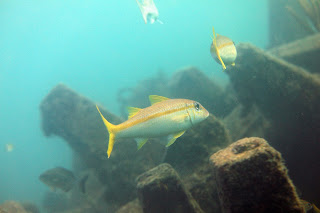The sunrise was striking and the sea was calm. I took her gear to the beach then returned for my gear while she managed to get into hers. She was her gear and in the water by the time I returned.
We swim out on the surface to help find the Jacks and to save our air for the dive instead of the trip to the site. We stay on a 100 degree bearing by keeping the parking lot lamppost along the Southern edge of the fire house chimney, but we watch the bottom for the three-tiered reef to know when to descend and look for the Jacks. Visibility today was so bad that we descended to see if we were over the reef. Turns out we were and we were close to the Jacks, too.
A Spotted Goatfish (Pseudupeneus maculatus) on the sand on the way back to the beach.
A Gray Snapper (Lutjanus griseus)
We swim out on the surface to help find the Jacks and to save our air for the dive instead of the trip to the site. We stay on a 100 degree bearing by keeping the parking lot lamppost along the Southern edge of the fire house chimney, but we watch the bottom for the three-tiered reef to know when to descend and look for the Jacks. Visibility today was so bad that we descended to see if we were over the reef. Turns out we were and we were close to the Jacks, too.
We followed a trail of single and double jacks to the line of Jacks and headed ENE. It was difficult to spot sea life. I shot some Palometa (Trachinotus goodei) I could barely see, but the pictures turned out fairly well.
Martha and I stayed close together in the poor visibility.
Along the way I spotted two French Grunts (Haemulon flavolineatum) apparently fighting over their respective Favorite spots on the Jacks.
A Yellow Goatfish (Mulloidichthys martinicus).
We reached the NE end of the Jacks at 2000 psi and turned the dive. We made our way to the beginning of the Jacks and left for the beach with about 900 psi. We came across a Hawksbill Sea Turtle on the shallow flat before the buoy line and I got some good pictures of that turtle.
Bottom time was 101 minutes; maximum depth was 25 feet. My SAC was 15.55 psi/minute and the RMV was 0.4 cubic feet /minute.
Hawksbill Sea Turtle (Eretmochelys imbricata)









